Implementing Evidence for Practice: Hand Hygiene and Infection Control
VerifiedAdded on 2020/03/16
|25
|7097
|67
Report
AI Summary
This report investigates the critical role of hand hygiene in clinical settings, focusing on its impact on infection control. It begins by summarizing the clinical issue of nosocomial infections caused by inadequate sanitation, highlighting the importance of hand washing by healthcare professionals. The report formulates a structured clinical question using the PICOT framework, followed by outlining a systematic search strategy to gather relevant evidence. It then presents findings from several studies in tabular form, critically reviewing the methodologies and outcomes. The report also analyzes the key implications of the reviewed evidence, identifies barriers and facilitators to implementation, and describes two evidence-based strategies for promoting hand hygiene within clinical settings. The report concludes by emphasizing the significance of maintaining sanitation and sterility to reduce infection rates, referencing multiple studies to support the recommendations.
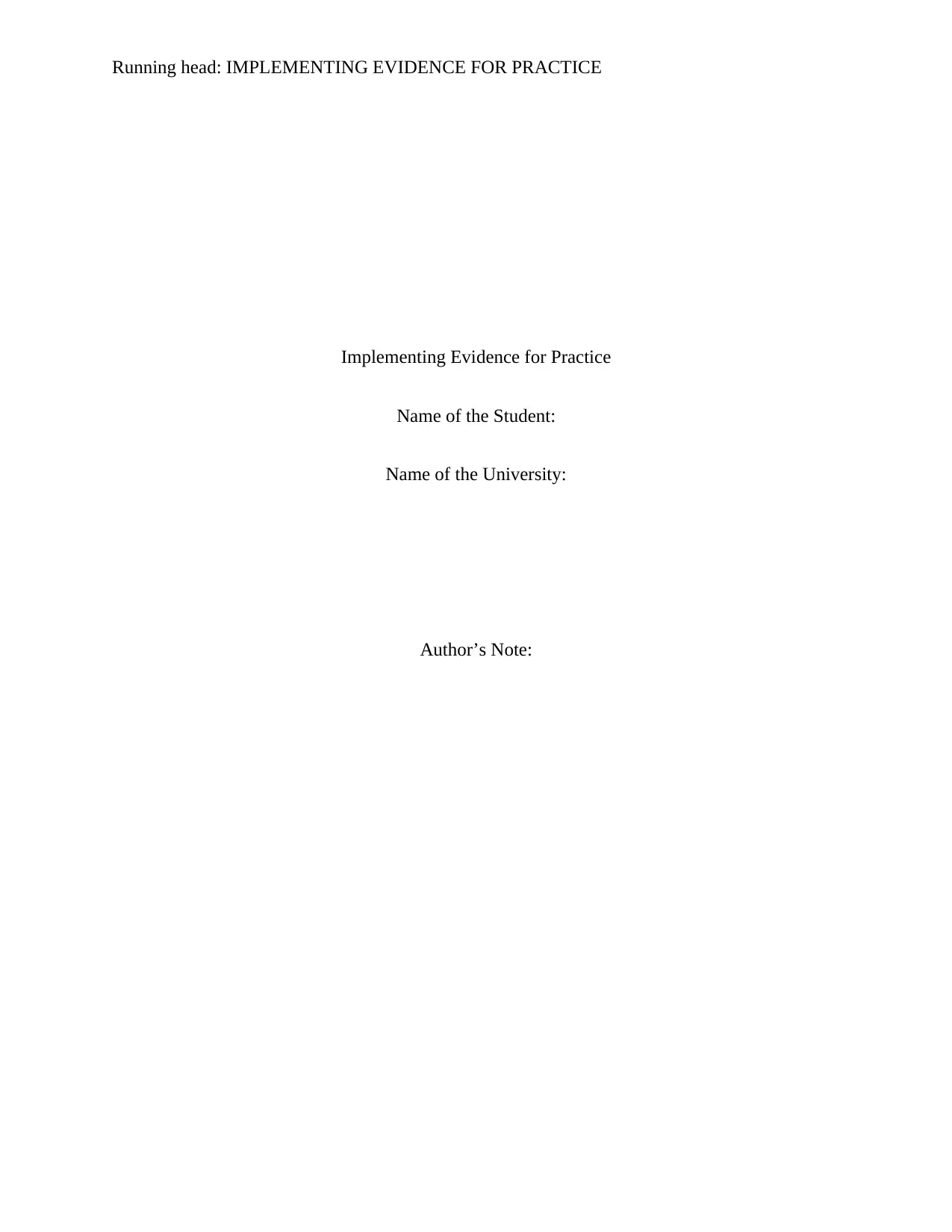
Running head: IMPLEMENTING EVIDENCE FOR PRACTICE
Implementing Evidence for Practice
Name of the Student:
Name of the University:
Author’s Note:
Implementing Evidence for Practice
Name of the Student:
Name of the University:
Author’s Note:
Paraphrase This Document
Need a fresh take? Get an instant paraphrase of this document with our AI Paraphraser
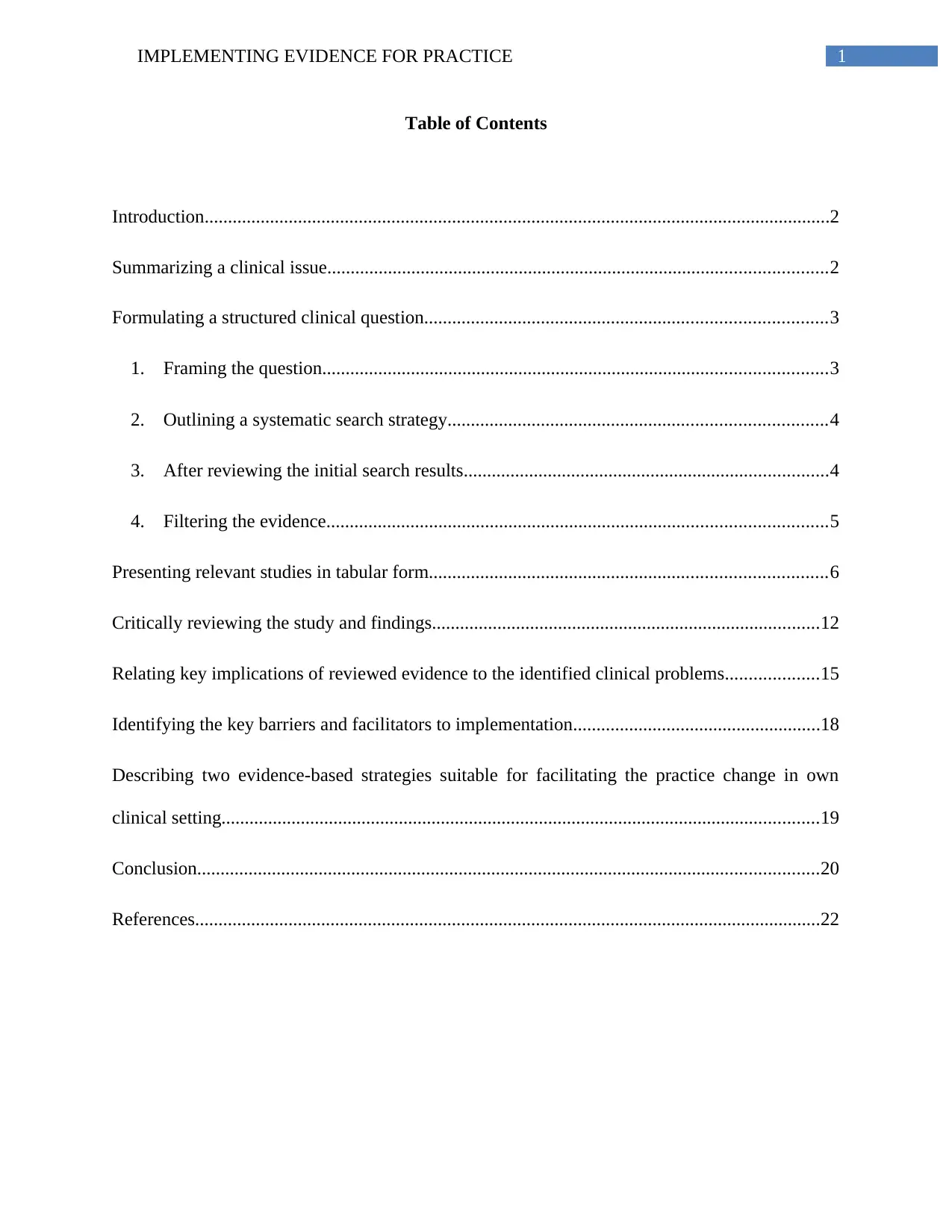
1IMPLEMENTING EVIDENCE FOR PRACTICE
Table of Contents
Introduction......................................................................................................................................2
Summarizing a clinical issue...........................................................................................................2
Formulating a structured clinical question......................................................................................3
1. Framing the question............................................................................................................3
2. Outlining a systematic search strategy.................................................................................4
3. After reviewing the initial search results..............................................................................4
4. Filtering the evidence...........................................................................................................5
Presenting relevant studies in tabular form.....................................................................................6
Critically reviewing the study and findings...................................................................................12
Relating key implications of reviewed evidence to the identified clinical problems....................15
Identifying the key barriers and facilitators to implementation.....................................................18
Describing two evidence-based strategies suitable for facilitating the practice change in own
clinical setting................................................................................................................................19
Conclusion.....................................................................................................................................20
References......................................................................................................................................22
Table of Contents
Introduction......................................................................................................................................2
Summarizing a clinical issue...........................................................................................................2
Formulating a structured clinical question......................................................................................3
1. Framing the question............................................................................................................3
2. Outlining a systematic search strategy.................................................................................4
3. After reviewing the initial search results..............................................................................4
4. Filtering the evidence...........................................................................................................5
Presenting relevant studies in tabular form.....................................................................................6
Critically reviewing the study and findings...................................................................................12
Relating key implications of reviewed evidence to the identified clinical problems....................15
Identifying the key barriers and facilitators to implementation.....................................................18
Describing two evidence-based strategies suitable for facilitating the practice change in own
clinical setting................................................................................................................................19
Conclusion.....................................................................................................................................20
References......................................................................................................................................22
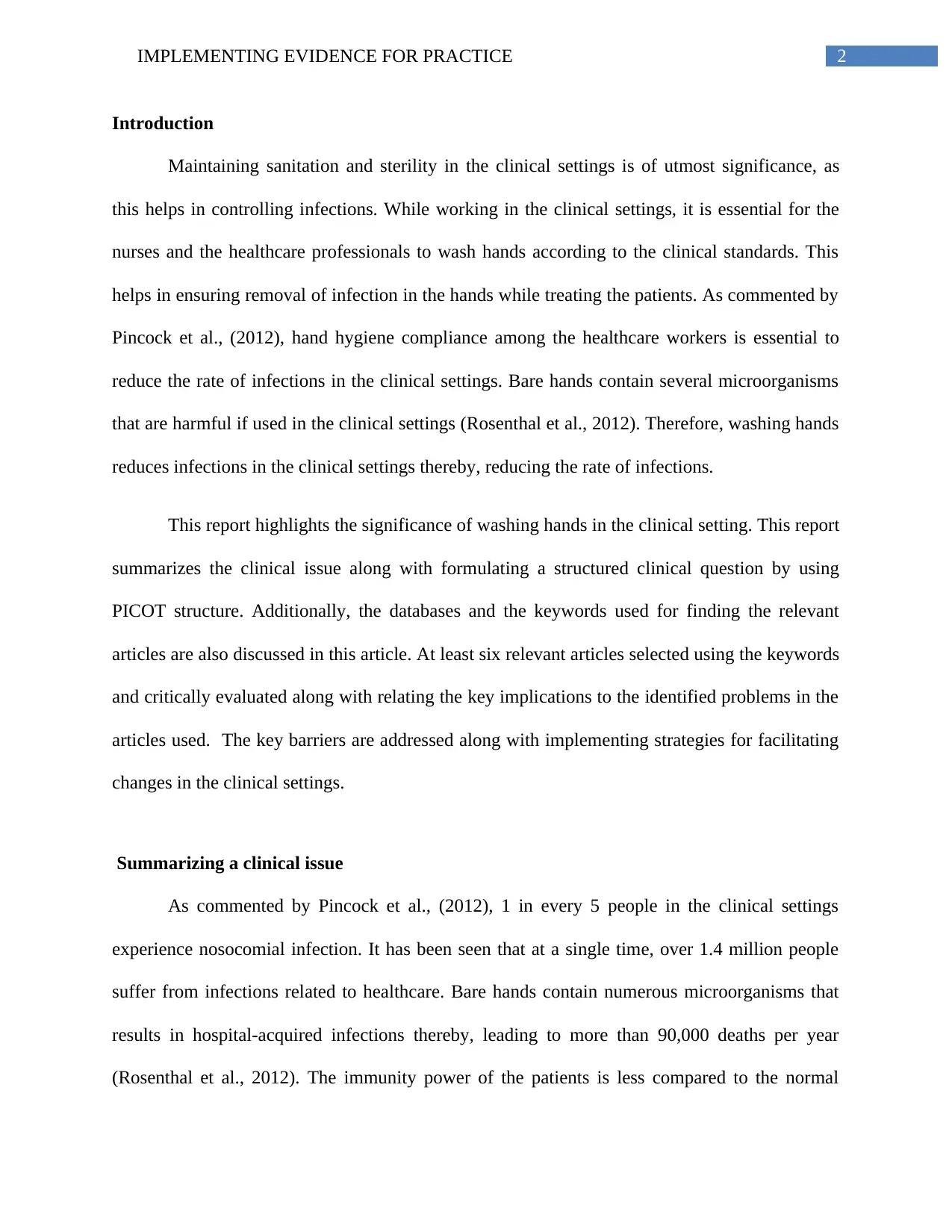
2IMPLEMENTING EVIDENCE FOR PRACTICE
Introduction
Maintaining sanitation and sterility in the clinical settings is of utmost significance, as
this helps in controlling infections. While working in the clinical settings, it is essential for the
nurses and the healthcare professionals to wash hands according to the clinical standards. This
helps in ensuring removal of infection in the hands while treating the patients. As commented by
Pincock et al., (2012), hand hygiene compliance among the healthcare workers is essential to
reduce the rate of infections in the clinical settings. Bare hands contain several microorganisms
that are harmful if used in the clinical settings (Rosenthal et al., 2012). Therefore, washing hands
reduces infections in the clinical settings thereby, reducing the rate of infections.
This report highlights the significance of washing hands in the clinical setting. This report
summarizes the clinical issue along with formulating a structured clinical question by using
PICOT structure. Additionally, the databases and the keywords used for finding the relevant
articles are also discussed in this article. At least six relevant articles selected using the keywords
and critically evaluated along with relating the key implications to the identified problems in the
articles used. The key barriers are addressed along with implementing strategies for facilitating
changes in the clinical settings.
Summarizing a clinical issue
As commented by Pincock et al., (2012), 1 in every 5 people in the clinical settings
experience nosocomial infection. It has been seen that at a single time, over 1.4 million people
suffer from infections related to healthcare. Bare hands contain numerous microorganisms that
results in hospital-acquired infections thereby, leading to more than 90,000 deaths per year
(Rosenthal et al., 2012). The immunity power of the patients is less compared to the normal
Introduction
Maintaining sanitation and sterility in the clinical settings is of utmost significance, as
this helps in controlling infections. While working in the clinical settings, it is essential for the
nurses and the healthcare professionals to wash hands according to the clinical standards. This
helps in ensuring removal of infection in the hands while treating the patients. As commented by
Pincock et al., (2012), hand hygiene compliance among the healthcare workers is essential to
reduce the rate of infections in the clinical settings. Bare hands contain several microorganisms
that are harmful if used in the clinical settings (Rosenthal et al., 2012). Therefore, washing hands
reduces infections in the clinical settings thereby, reducing the rate of infections.
This report highlights the significance of washing hands in the clinical setting. This report
summarizes the clinical issue along with formulating a structured clinical question by using
PICOT structure. Additionally, the databases and the keywords used for finding the relevant
articles are also discussed in this article. At least six relevant articles selected using the keywords
and critically evaluated along with relating the key implications to the identified problems in the
articles used. The key barriers are addressed along with implementing strategies for facilitating
changes in the clinical settings.
Summarizing a clinical issue
As commented by Pincock et al., (2012), 1 in every 5 people in the clinical settings
experience nosocomial infection. It has been seen that at a single time, over 1.4 million people
suffer from infections related to healthcare. Bare hands contain numerous microorganisms that
results in hospital-acquired infections thereby, leading to more than 90,000 deaths per year
(Rosenthal et al., 2012). The immunity power of the patients is less compared to the normal
⊘ This is a preview!⊘
Do you want full access?
Subscribe today to unlock all pages.

Trusted by 1+ million students worldwide
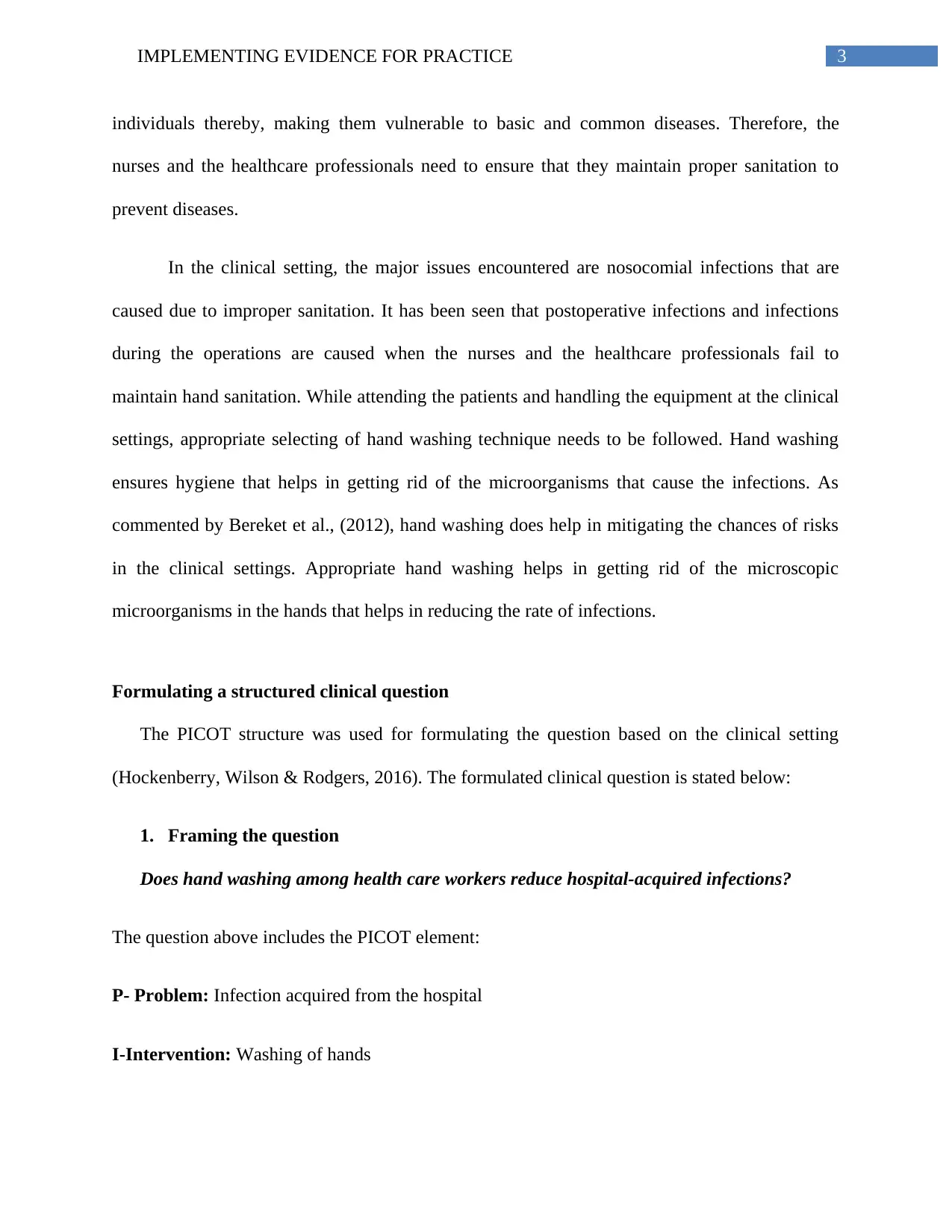
3IMPLEMENTING EVIDENCE FOR PRACTICE
individuals thereby, making them vulnerable to basic and common diseases. Therefore, the
nurses and the healthcare professionals need to ensure that they maintain proper sanitation to
prevent diseases.
In the clinical setting, the major issues encountered are nosocomial infections that are
caused due to improper sanitation. It has been seen that postoperative infections and infections
during the operations are caused when the nurses and the healthcare professionals fail to
maintain hand sanitation. While attending the patients and handling the equipment at the clinical
settings, appropriate selecting of hand washing technique needs to be followed. Hand washing
ensures hygiene that helps in getting rid of the microorganisms that cause the infections. As
commented by Bereket et al., (2012), hand washing does help in mitigating the chances of risks
in the clinical settings. Appropriate hand washing helps in getting rid of the microscopic
microorganisms in the hands that helps in reducing the rate of infections.
Formulating a structured clinical question
The PICOT structure was used for formulating the question based on the clinical setting
(Hockenberry, Wilson & Rodgers, 2016). The formulated clinical question is stated below:
1. Framing the question
Does hand washing among health care workers reduce hospital-acquired infections?
The question above includes the PICOT element:
P- Problem: Infection acquired from the hospital
I-Intervention: Washing of hands
individuals thereby, making them vulnerable to basic and common diseases. Therefore, the
nurses and the healthcare professionals need to ensure that they maintain proper sanitation to
prevent diseases.
In the clinical setting, the major issues encountered are nosocomial infections that are
caused due to improper sanitation. It has been seen that postoperative infections and infections
during the operations are caused when the nurses and the healthcare professionals fail to
maintain hand sanitation. While attending the patients and handling the equipment at the clinical
settings, appropriate selecting of hand washing technique needs to be followed. Hand washing
ensures hygiene that helps in getting rid of the microorganisms that cause the infections. As
commented by Bereket et al., (2012), hand washing does help in mitigating the chances of risks
in the clinical settings. Appropriate hand washing helps in getting rid of the microscopic
microorganisms in the hands that helps in reducing the rate of infections.
Formulating a structured clinical question
The PICOT structure was used for formulating the question based on the clinical setting
(Hockenberry, Wilson & Rodgers, 2016). The formulated clinical question is stated below:
1. Framing the question
Does hand washing among health care workers reduce hospital-acquired infections?
The question above includes the PICOT element:
P- Problem: Infection acquired from the hospital
I-Intervention: Washing of hands
Paraphrase This Document
Need a fresh take? Get an instant paraphrase of this document with our AI Paraphraser
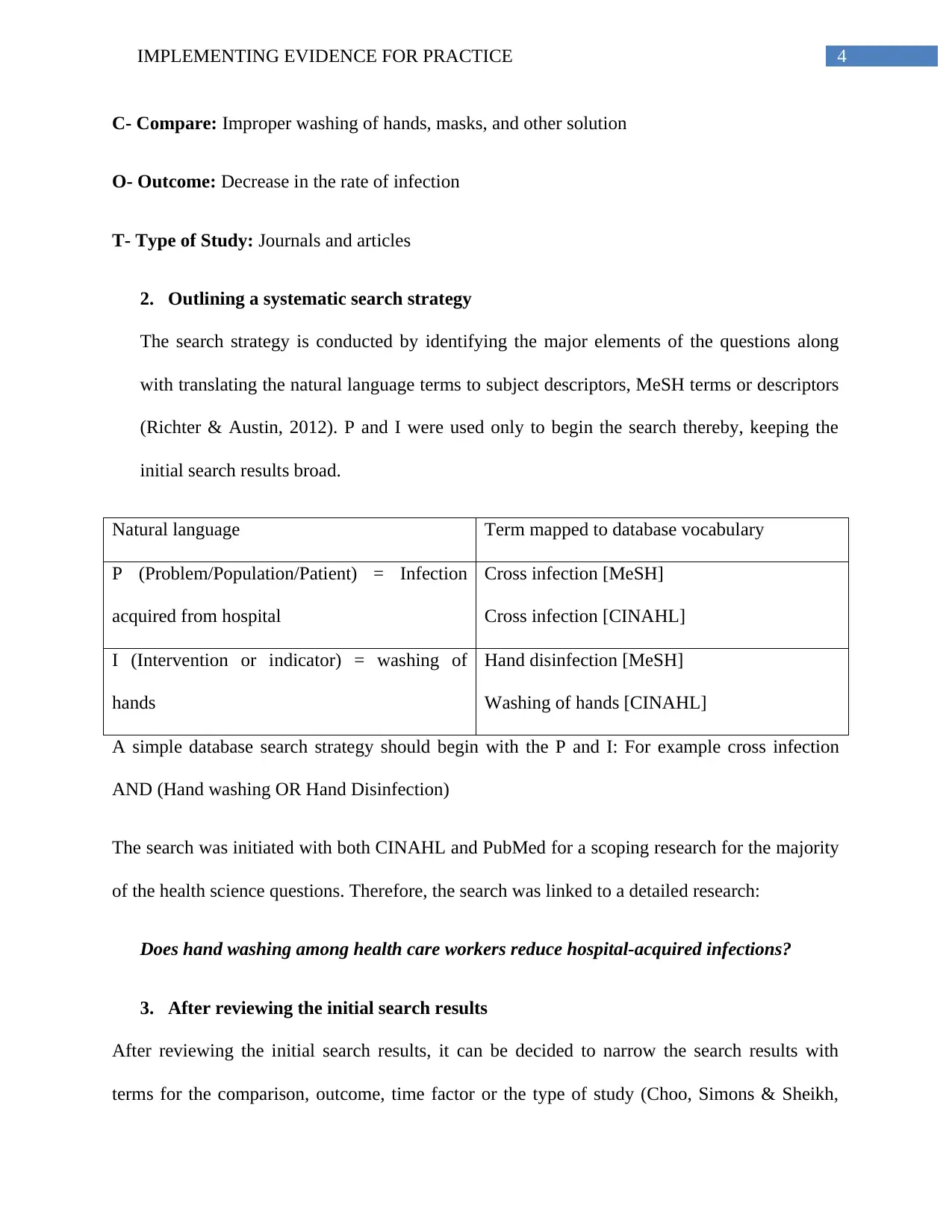
4IMPLEMENTING EVIDENCE FOR PRACTICE
C- Compare: Improper washing of hands, masks, and other solution
O- Outcome: Decrease in the rate of infection
T- Type of Study: Journals and articles
2. Outlining a systematic search strategy
The search strategy is conducted by identifying the major elements of the questions along
with translating the natural language terms to subject descriptors, MeSH terms or descriptors
(Richter & Austin, 2012). P and I were used only to begin the search thereby, keeping the
initial search results broad.
Natural language Term mapped to database vocabulary
P (Problem/Population/Patient) = Infection
acquired from hospital
Cross infection [MeSH]
Cross infection [CINAHL]
I (Intervention or indicator) = washing of
hands
Hand disinfection [MeSH]
Washing of hands [CINAHL]
A simple database search strategy should begin with the P and I: For example cross infection
AND (Hand washing OR Hand Disinfection)
The search was initiated with both CINAHL and PubMed for a scoping research for the majority
of the health science questions. Therefore, the search was linked to a detailed research:
Does hand washing among health care workers reduce hospital-acquired infections?
3. After reviewing the initial search results
After reviewing the initial search results, it can be decided to narrow the search results with
terms for the comparison, outcome, time factor or the type of study (Choo, Simons & Sheikh,
C- Compare: Improper washing of hands, masks, and other solution
O- Outcome: Decrease in the rate of infection
T- Type of Study: Journals and articles
2. Outlining a systematic search strategy
The search strategy is conducted by identifying the major elements of the questions along
with translating the natural language terms to subject descriptors, MeSH terms or descriptors
(Richter & Austin, 2012). P and I were used only to begin the search thereby, keeping the
initial search results broad.
Natural language Term mapped to database vocabulary
P (Problem/Population/Patient) = Infection
acquired from hospital
Cross infection [MeSH]
Cross infection [CINAHL]
I (Intervention or indicator) = washing of
hands
Hand disinfection [MeSH]
Washing of hands [CINAHL]
A simple database search strategy should begin with the P and I: For example cross infection
AND (Hand washing OR Hand Disinfection)
The search was initiated with both CINAHL and PubMed for a scoping research for the majority
of the health science questions. Therefore, the search was linked to a detailed research:
Does hand washing among health care workers reduce hospital-acquired infections?
3. After reviewing the initial search results
After reviewing the initial search results, it can be decided to narrow the search results with
terms for the comparison, outcome, time factor or the type of study (Choo, Simons & Sheikh,
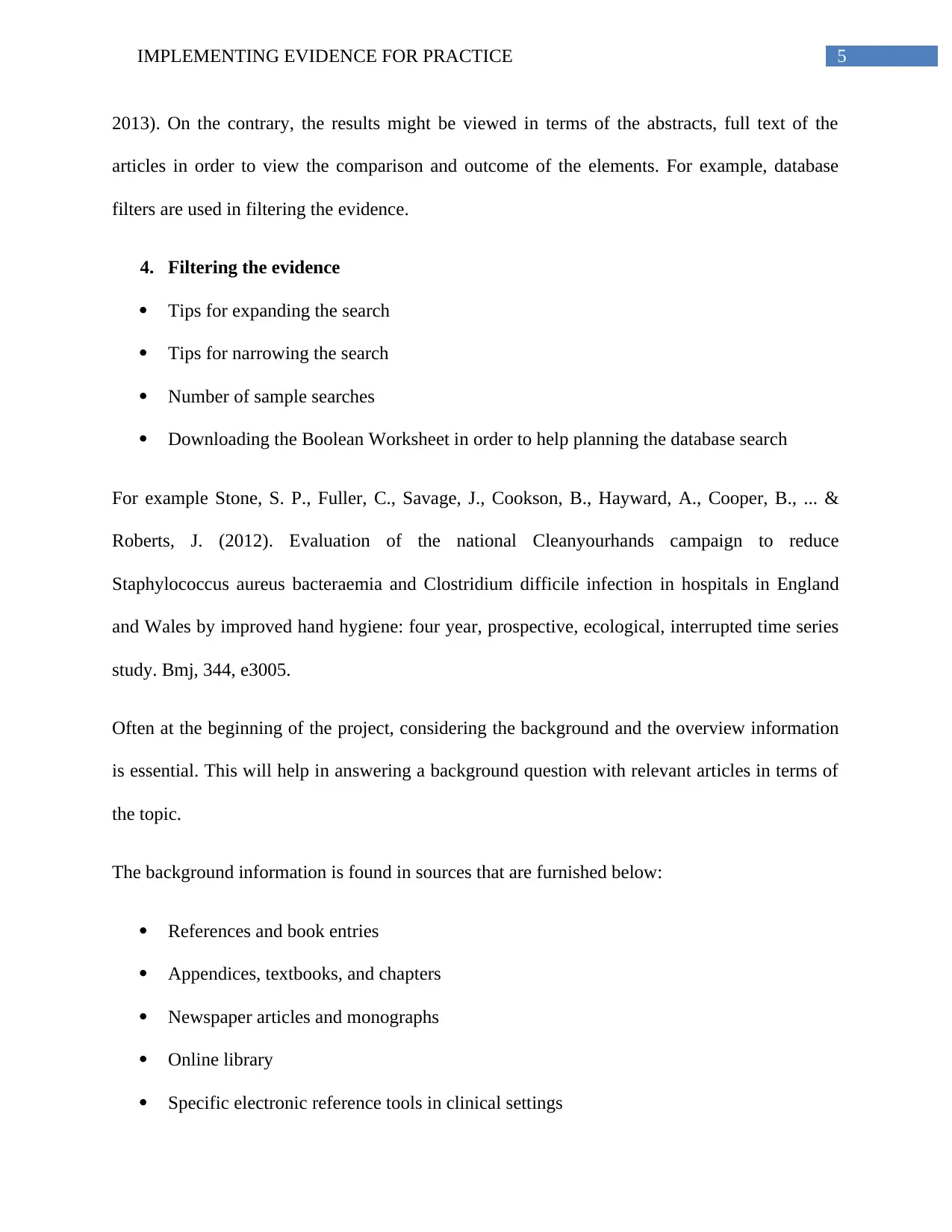
5IMPLEMENTING EVIDENCE FOR PRACTICE
2013). On the contrary, the results might be viewed in terms of the abstracts, full text of the
articles in order to view the comparison and outcome of the elements. For example, database
filters are used in filtering the evidence.
4. Filtering the evidence
Tips for expanding the search
Tips for narrowing the search
Number of sample searches
Downloading the Boolean Worksheet in order to help planning the database search
For example Stone, S. P., Fuller, C., Savage, J., Cookson, B., Hayward, A., Cooper, B., ... &
Roberts, J. (2012). Evaluation of the national Cleanyourhands campaign to reduce
Staphylococcus aureus bacteraemia and Clostridium difficile infection in hospitals in England
and Wales by improved hand hygiene: four year, prospective, ecological, interrupted time series
study. Bmj, 344, e3005.
Often at the beginning of the project, considering the background and the overview information
is essential. This will help in answering a background question with relevant articles in terms of
the topic.
The background information is found in sources that are furnished below:
References and book entries
Appendices, textbooks, and chapters
Newspaper articles and monographs
Online library
Specific electronic reference tools in clinical settings
2013). On the contrary, the results might be viewed in terms of the abstracts, full text of the
articles in order to view the comparison and outcome of the elements. For example, database
filters are used in filtering the evidence.
4. Filtering the evidence
Tips for expanding the search
Tips for narrowing the search
Number of sample searches
Downloading the Boolean Worksheet in order to help planning the database search
For example Stone, S. P., Fuller, C., Savage, J., Cookson, B., Hayward, A., Cooper, B., ... &
Roberts, J. (2012). Evaluation of the national Cleanyourhands campaign to reduce
Staphylococcus aureus bacteraemia and Clostridium difficile infection in hospitals in England
and Wales by improved hand hygiene: four year, prospective, ecological, interrupted time series
study. Bmj, 344, e3005.
Often at the beginning of the project, considering the background and the overview information
is essential. This will help in answering a background question with relevant articles in terms of
the topic.
The background information is found in sources that are furnished below:
References and book entries
Appendices, textbooks, and chapters
Newspaper articles and monographs
Online library
Specific electronic reference tools in clinical settings
⊘ This is a preview!⊘
Do you want full access?
Subscribe today to unlock all pages.

Trusted by 1+ million students worldwide
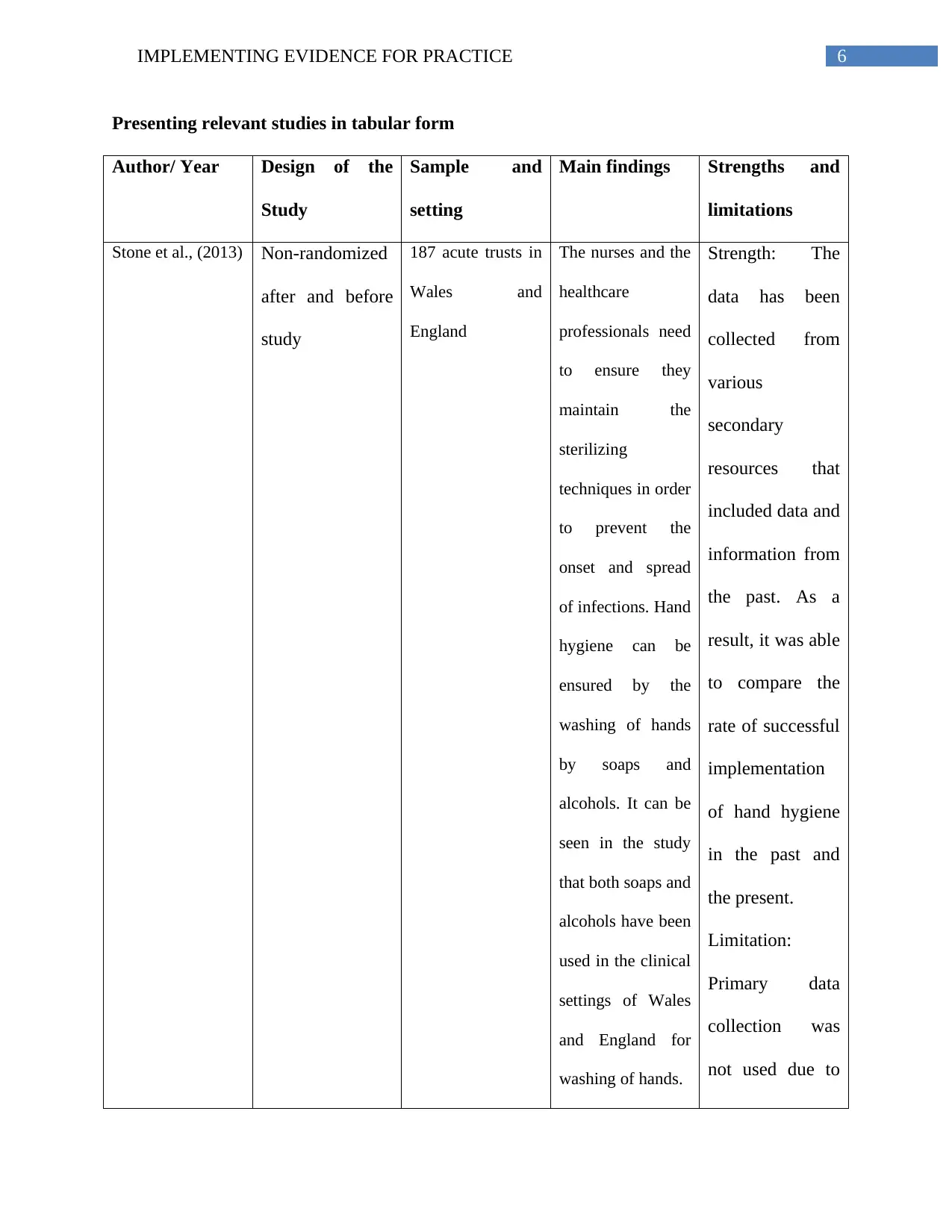
6IMPLEMENTING EVIDENCE FOR PRACTICE
Presenting relevant studies in tabular form
Author/ Year Design of the
Study
Sample and
setting
Main findings Strengths and
limitations
Stone et al., (2013) Non-randomized
after and before
study
187 acute trusts in
Wales and
England
The nurses and the
healthcare
professionals need
to ensure they
maintain the
sterilizing
techniques in order
to prevent the
onset and spread
of infections. Hand
hygiene can be
ensured by the
washing of hands
by soaps and
alcohols. It can be
seen in the study
that both soaps and
alcohols have been
used in the clinical
settings of Wales
and England for
washing of hands.
Strength: The
data has been
collected from
various
secondary
resources that
included data and
information from
the past. As a
result, it was able
to compare the
rate of successful
implementation
of hand hygiene
in the past and
the present.
Limitation:
Primary data
collection was
not used due to
Presenting relevant studies in tabular form
Author/ Year Design of the
Study
Sample and
setting
Main findings Strengths and
limitations
Stone et al., (2013) Non-randomized
after and before
study
187 acute trusts in
Wales and
England
The nurses and the
healthcare
professionals need
to ensure they
maintain the
sterilizing
techniques in order
to prevent the
onset and spread
of infections. Hand
hygiene can be
ensured by the
washing of hands
by soaps and
alcohols. It can be
seen in the study
that both soaps and
alcohols have been
used in the clinical
settings of Wales
and England for
washing of hands.
Strength: The
data has been
collected from
various
secondary
resources that
included data and
information from
the past. As a
result, it was able
to compare the
rate of successful
implementation
of hand hygiene
in the past and
the present.
Limitation:
Primary data
collection was
not used due to
Paraphrase This Document
Need a fresh take? Get an instant paraphrase of this document with our AI Paraphraser
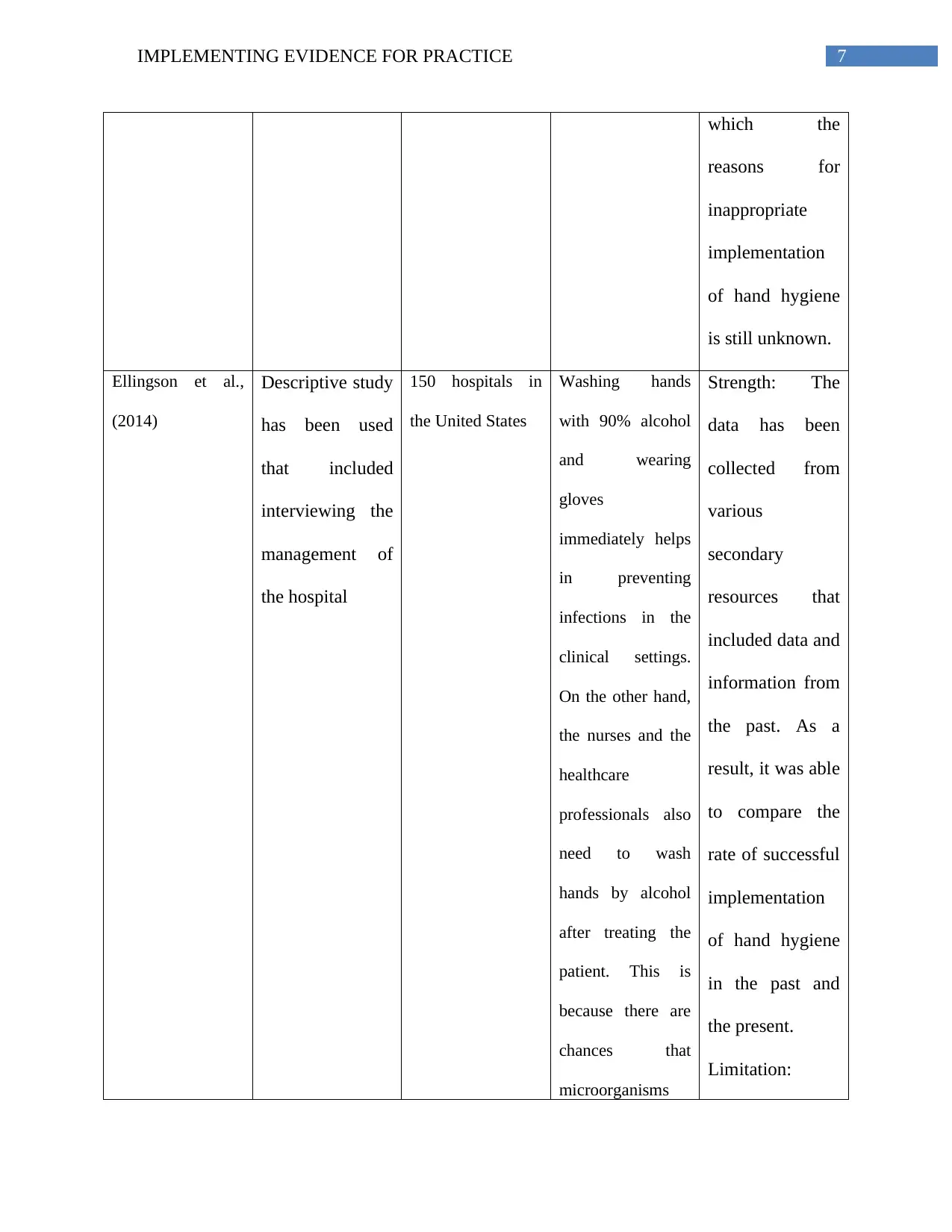
7IMPLEMENTING EVIDENCE FOR PRACTICE
which the
reasons for
inappropriate
implementation
of hand hygiene
is still unknown.
Ellingson et al.,
(2014)
Descriptive study
has been used
that included
interviewing the
management of
the hospital
150 hospitals in
the United States
Washing hands
with 90% alcohol
and wearing
gloves
immediately helps
in preventing
infections in the
clinical settings.
On the other hand,
the nurses and the
healthcare
professionals also
need to wash
hands by alcohol
after treating the
patient. This is
because there are
chances that
microorganisms
Strength: The
data has been
collected from
various
secondary
resources that
included data and
information from
the past. As a
result, it was able
to compare the
rate of successful
implementation
of hand hygiene
in the past and
the present.
Limitation:
which the
reasons for
inappropriate
implementation
of hand hygiene
is still unknown.
Ellingson et al.,
(2014)
Descriptive study
has been used
that included
interviewing the
management of
the hospital
150 hospitals in
the United States
Washing hands
with 90% alcohol
and wearing
gloves
immediately helps
in preventing
infections in the
clinical settings.
On the other hand,
the nurses and the
healthcare
professionals also
need to wash
hands by alcohol
after treating the
patient. This is
because there are
chances that
microorganisms
Strength: The
data has been
collected from
various
secondary
resources that
included data and
information from
the past. As a
result, it was able
to compare the
rate of successful
implementation
of hand hygiene
in the past and
the present.
Limitation:
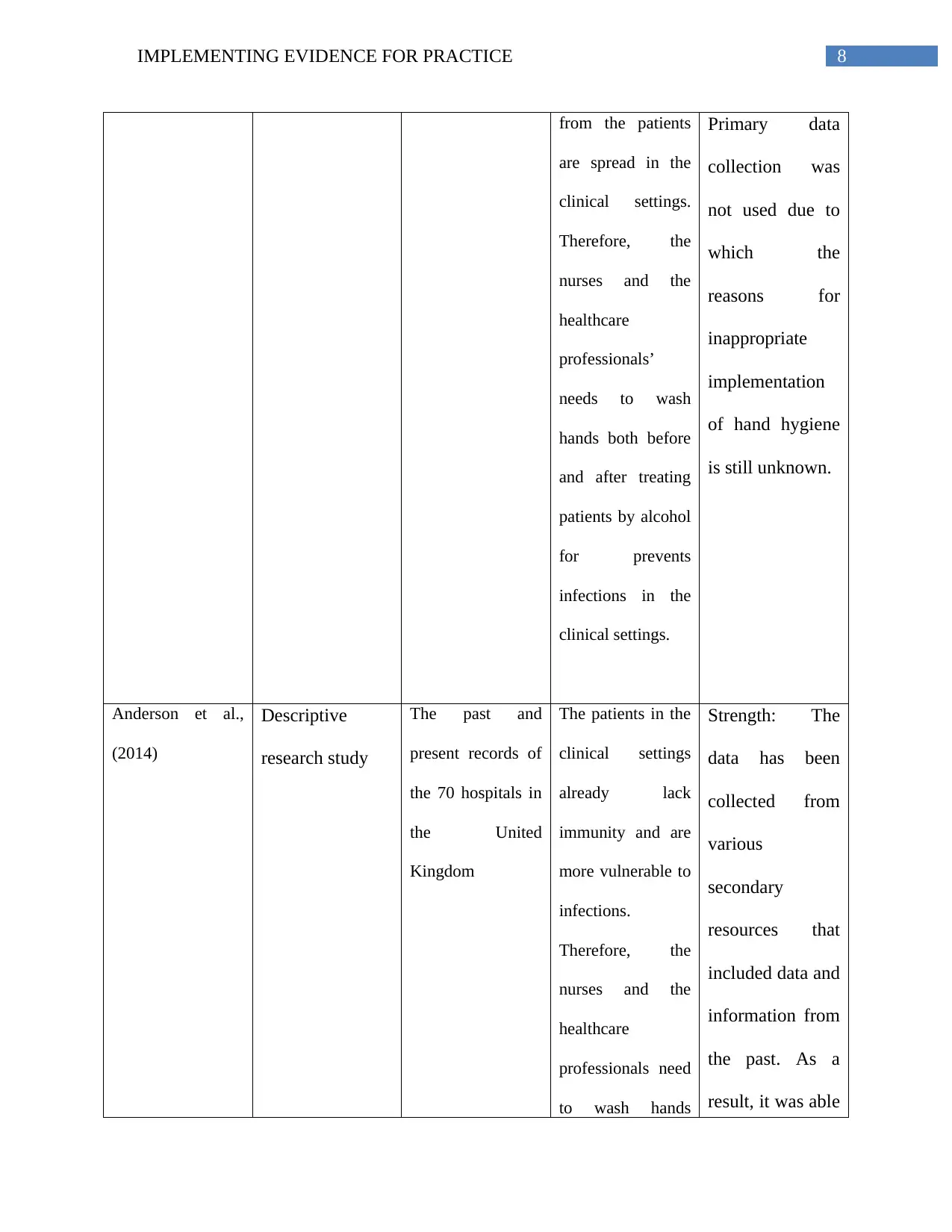
8IMPLEMENTING EVIDENCE FOR PRACTICE
from the patients
are spread in the
clinical settings.
Therefore, the
nurses and the
healthcare
professionals’
needs to wash
hands both before
and after treating
patients by alcohol
for prevents
infections in the
clinical settings.
Primary data
collection was
not used due to
which the
reasons for
inappropriate
implementation
of hand hygiene
is still unknown.
Anderson et al.,
(2014)
Descriptive
research study
The past and
present records of
the 70 hospitals in
the United
Kingdom
The patients in the
clinical settings
already lack
immunity and are
more vulnerable to
infections.
Therefore, the
nurses and the
healthcare
professionals need
to wash hands
Strength: The
data has been
collected from
various
secondary
resources that
included data and
information from
the past. As a
result, it was able
from the patients
are spread in the
clinical settings.
Therefore, the
nurses and the
healthcare
professionals’
needs to wash
hands both before
and after treating
patients by alcohol
for prevents
infections in the
clinical settings.
Primary data
collection was
not used due to
which the
reasons for
inappropriate
implementation
of hand hygiene
is still unknown.
Anderson et al.,
(2014)
Descriptive
research study
The past and
present records of
the 70 hospitals in
the United
Kingdom
The patients in the
clinical settings
already lack
immunity and are
more vulnerable to
infections.
Therefore, the
nurses and the
healthcare
professionals need
to wash hands
Strength: The
data has been
collected from
various
secondary
resources that
included data and
information from
the past. As a
result, it was able
⊘ This is a preview!⊘
Do you want full access?
Subscribe today to unlock all pages.

Trusted by 1+ million students worldwide
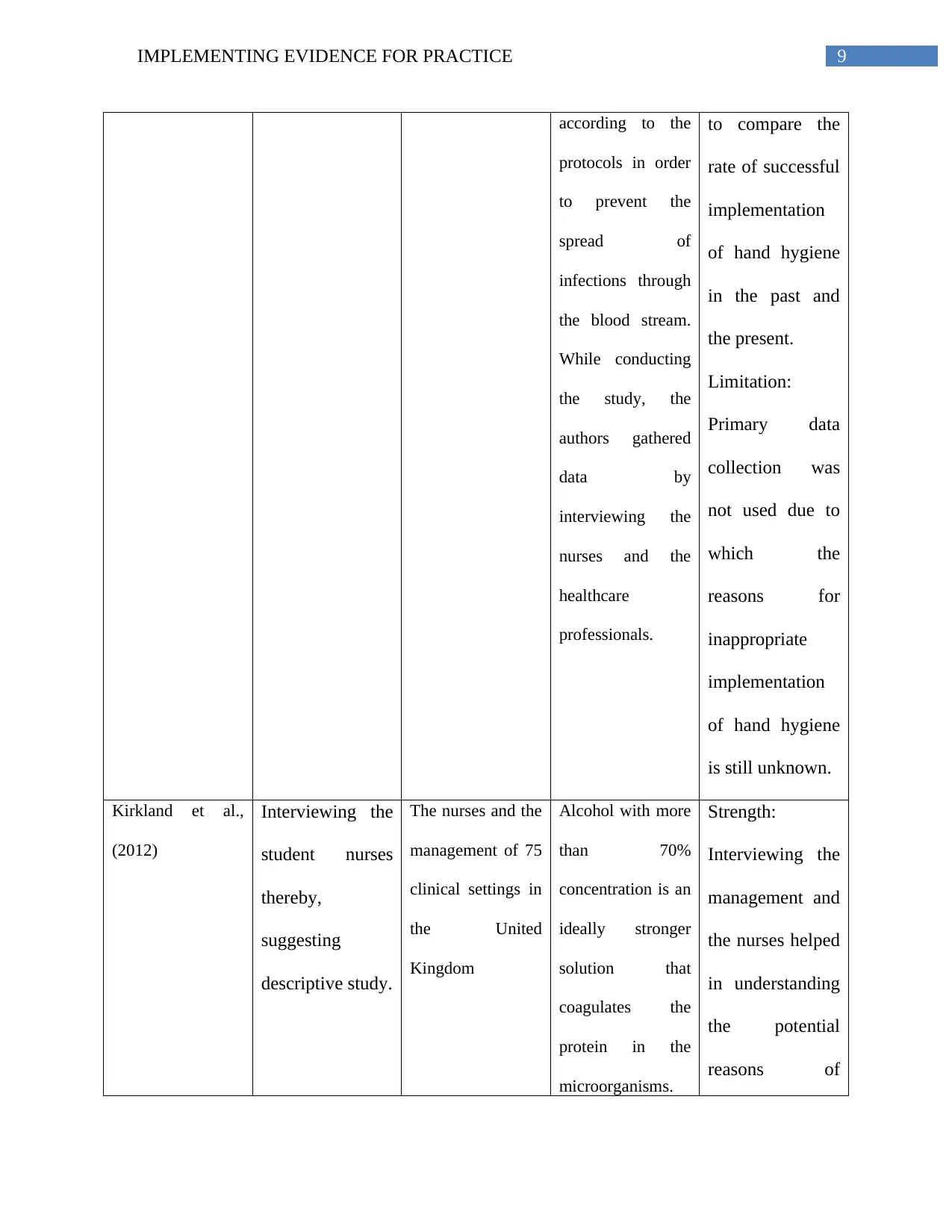
9IMPLEMENTING EVIDENCE FOR PRACTICE
according to the
protocols in order
to prevent the
spread of
infections through
the blood stream.
While conducting
the study, the
authors gathered
data by
interviewing the
nurses and the
healthcare
professionals.
to compare the
rate of successful
implementation
of hand hygiene
in the past and
the present.
Limitation:
Primary data
collection was
not used due to
which the
reasons for
inappropriate
implementation
of hand hygiene
is still unknown.
Kirkland et al.,
(2012)
Interviewing the
student nurses
thereby,
suggesting
descriptive study.
The nurses and the
management of 75
clinical settings in
the United
Kingdom
Alcohol with more
than 70%
concentration is an
ideally stronger
solution that
coagulates the
protein in the
microorganisms.
Strength:
Interviewing the
management and
the nurses helped
in understanding
the potential
reasons of
according to the
protocols in order
to prevent the
spread of
infections through
the blood stream.
While conducting
the study, the
authors gathered
data by
interviewing the
nurses and the
healthcare
professionals.
to compare the
rate of successful
implementation
of hand hygiene
in the past and
the present.
Limitation:
Primary data
collection was
not used due to
which the
reasons for
inappropriate
implementation
of hand hygiene
is still unknown.
Kirkland et al.,
(2012)
Interviewing the
student nurses
thereby,
suggesting
descriptive study.
The nurses and the
management of 75
clinical settings in
the United
Kingdom
Alcohol with more
than 70%
concentration is an
ideally stronger
solution that
coagulates the
protein in the
microorganisms.
Strength:
Interviewing the
management and
the nurses helped
in understanding
the potential
reasons of
Paraphrase This Document
Need a fresh take? Get an instant paraphrase of this document with our AI Paraphraser
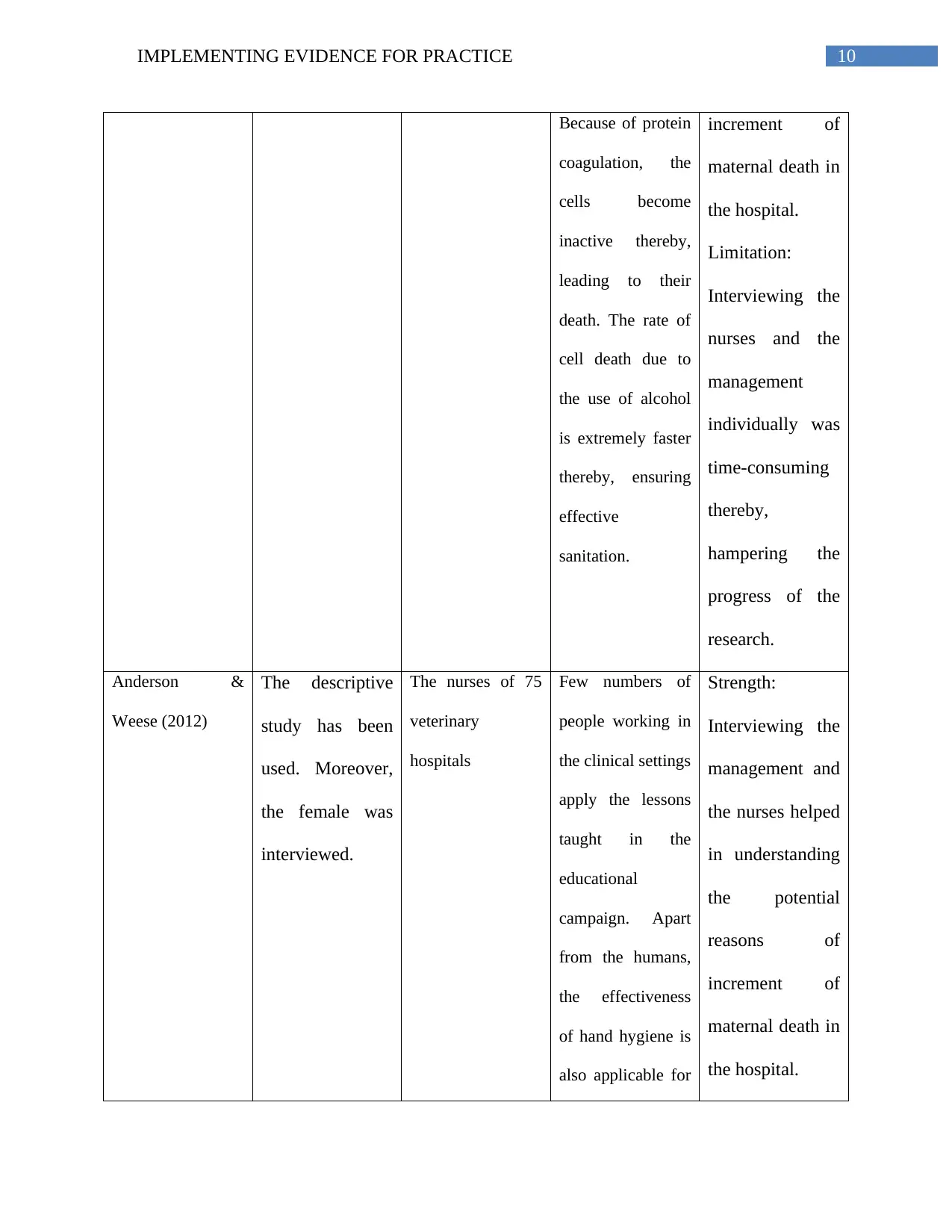
10IMPLEMENTING EVIDENCE FOR PRACTICE
Because of protein
coagulation, the
cells become
inactive thereby,
leading to their
death. The rate of
cell death due to
the use of alcohol
is extremely faster
thereby, ensuring
effective
sanitation.
increment of
maternal death in
the hospital.
Limitation:
Interviewing the
nurses and the
management
individually was
time-consuming
thereby,
hampering the
progress of the
research.
Anderson &
Weese (2012)
The descriptive
study has been
used. Moreover,
the female was
interviewed.
The nurses of 75
veterinary
hospitals
Few numbers of
people working in
the clinical settings
apply the lessons
taught in the
educational
campaign. Apart
from the humans,
the effectiveness
of hand hygiene is
also applicable for
Strength:
Interviewing the
management and
the nurses helped
in understanding
the potential
reasons of
increment of
maternal death in
the hospital.
Because of protein
coagulation, the
cells become
inactive thereby,
leading to their
death. The rate of
cell death due to
the use of alcohol
is extremely faster
thereby, ensuring
effective
sanitation.
increment of
maternal death in
the hospital.
Limitation:
Interviewing the
nurses and the
management
individually was
time-consuming
thereby,
hampering the
progress of the
research.
Anderson &
Weese (2012)
The descriptive
study has been
used. Moreover,
the female was
interviewed.
The nurses of 75
veterinary
hospitals
Few numbers of
people working in
the clinical settings
apply the lessons
taught in the
educational
campaign. Apart
from the humans,
the effectiveness
of hand hygiene is
also applicable for
Strength:
Interviewing the
management and
the nurses helped
in understanding
the potential
reasons of
increment of
maternal death in
the hospital.
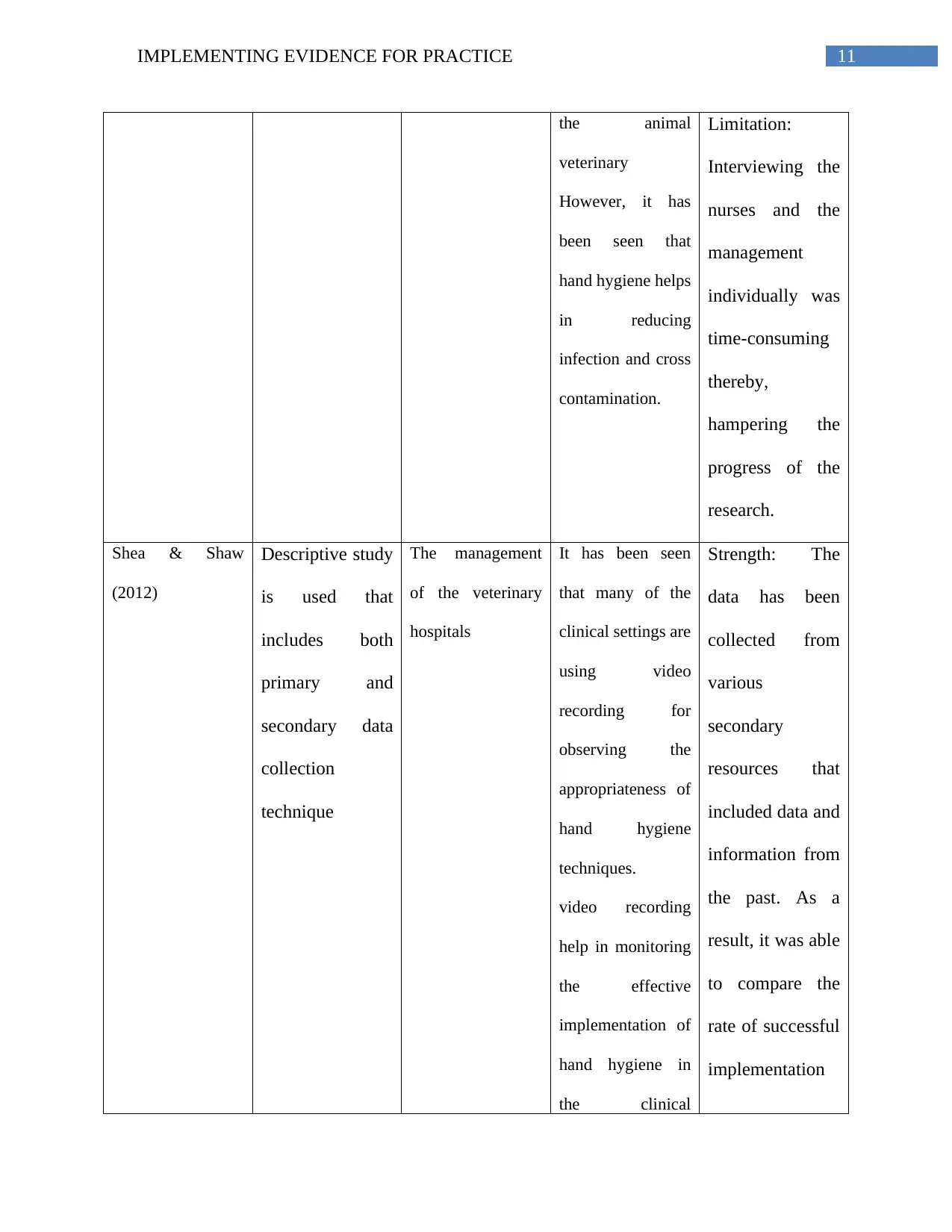
11IMPLEMENTING EVIDENCE FOR PRACTICE
the animal
veterinary
However, it has
been seen that
hand hygiene helps
in reducing
infection and cross
contamination.
Limitation:
Interviewing the
nurses and the
management
individually was
time-consuming
thereby,
hampering the
progress of the
research.
Shea & Shaw
(2012)
Descriptive study
is used that
includes both
primary and
secondary data
collection
technique
The management
of the veterinary
hospitals
It has been seen
that many of the
clinical settings are
using video
recording for
observing the
appropriateness of
hand hygiene
techniques.
video recording
help in monitoring
the effective
implementation of
hand hygiene in
the clinical
Strength: The
data has been
collected from
various
secondary
resources that
included data and
information from
the past. As a
result, it was able
to compare the
rate of successful
implementation
the animal
veterinary
However, it has
been seen that
hand hygiene helps
in reducing
infection and cross
contamination.
Limitation:
Interviewing the
nurses and the
management
individually was
time-consuming
thereby,
hampering the
progress of the
research.
Shea & Shaw
(2012)
Descriptive study
is used that
includes both
primary and
secondary data
collection
technique
The management
of the veterinary
hospitals
It has been seen
that many of the
clinical settings are
using video
recording for
observing the
appropriateness of
hand hygiene
techniques.
video recording
help in monitoring
the effective
implementation of
hand hygiene in
the clinical
Strength: The
data has been
collected from
various
secondary
resources that
included data and
information from
the past. As a
result, it was able
to compare the
rate of successful
implementation
⊘ This is a preview!⊘
Do you want full access?
Subscribe today to unlock all pages.

Trusted by 1+ million students worldwide
1 out of 25
Related Documents
Your All-in-One AI-Powered Toolkit for Academic Success.
+13062052269
info@desklib.com
Available 24*7 on WhatsApp / Email
![[object Object]](/_next/static/media/star-bottom.7253800d.svg)
Unlock your academic potential
Copyright © 2020–2025 A2Z Services. All Rights Reserved. Developed and managed by ZUCOL.





